Duck Tack
The elegance of the Duck-Tack is in the brief moment where time is suspended as the sail floats in air waiting to be reunited with the sailor. However do not be misled, the duck tack is a very difficult move to learn and even more so to master. Many accomplished sailors have tried to learn this move only to set it aside after much frustration. So, be patient and kind to yourself during the process of learning this challenging maneuver.
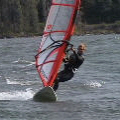
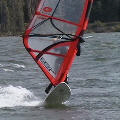
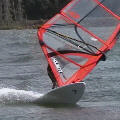
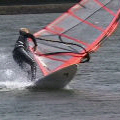
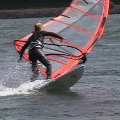
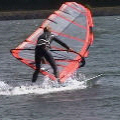
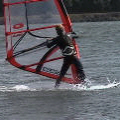
Rider: Royn Bartholdi
Steps
 1)
Unhook and get out of the foot straps.
1)
Unhook and get out of the foot straps.  2)
While on a beam reach, switch stance by turning your body into the wind and shuffling your feet. Your feet should be slightly over the centerline and your front foot should be near the mast and pointing slightly forward to the nose of the board.
2)
While on a beam reach, switch stance by turning your body into the wind and shuffling your feet. Your feet should be slightly over the centerline and your front foot should be near the mast and pointing slightly forward to the nose of the board.  3)
Carve upwind by putting pressure on the windward rails while keeping your body balanced over the board and not leaning out over the water. Extend your arms forward into the wind so the sail goes forward into the apparent wind: Use the back hand to throw the sail and the front hand to guide the sail. The front hand should let go of the boom and grab the boom end near the clew. Your arms will briefly cross.
3)
Carve upwind by putting pressure on the windward rails while keeping your body balanced over the board and not leaning out over the water. Extend your arms forward into the wind so the sail goes forward into the apparent wind: Use the back hand to throw the sail and the front hand to guide the sail. The front hand should let go of the boom and grab the boom end near the clew. Your arms will briefly cross.  4)
Let the clew pass by your head, let go of the back hand, and pull clew back and down toward the tail of the board with determination and quickness. By down, I mean into the wind for the clew must accelerate to the water faster than the mast for the sail to float.
4)
Let the clew pass by your head, let go of the back hand, and pull clew back and down toward the tail of the board with determination and quickness. By down, I mean into the wind for the clew must accelerate to the water faster than the mast for the sail to float.  5)
Let go (the sail will float in front of you) and step forward with your front foot.
5)
Let go (the sail will float in front of you) and step forward with your front foot.  6)
Reach for the boom as close to the mast as possible as the board stalls in the eye of the wind. Push out with the clew hand to keep power in your sail and stiffen the back leg to help turn the board into the wind.
6)
Reach for the boom as close to the mast as possible as the board stalls in the eye of the wind. Push out with the clew hand to keep power in your sail and stiffen the back leg to help turn the board into the wind.  7)
Once the board is pointing into the eye of the wind (or very close anyway) then pull the rig vertical and sheet in with the clew to power up the sail. Pressure your front foot so the nose of the board continues to pass into the new direction. Adjust feet, trim, sail away.
7)
Once the board is pointing into the eye of the wind (or very close anyway) then pull the rig vertical and sheet in with the clew to power up the sail. Pressure your front foot so the nose of the board continues to pass into the new direction. Adjust feet, trim, sail away. Videos
Loading the player ...
This Duck Tack is performed on a direct reach across the wind on a short board in high wind. Notice the aggresive hop to the switch stance position and the sail duck. Also notice the sail hits the water but pops back up by pushing on the sail with the rear hand and grabbing the boom with the mast hand.
Tips
- Being aware of the wind direction and sail position through the entire move is critical in this maneuver.
- Be patient, it takes a great deal of practice to coordinate all the action in this move. Timing and precision are critical with very little room for mistakes.
- Practice the heading up wind and switch stance section of the move until you have stability in your approach. This means your legs will be bent in a squat position and relying on your feet for balance by not draping on the sail.
- If the sail smashes into the water then the sail is getting backwinded and something is wrong.
- You might be releasing the sail wrong by throwing the sail forward and down or slightly pushing up with your clew hand when you release. Keep the hands close to the body even while you bring the sail forward.
- You might be heading to far up wind so throw the sail a little earlier.
- Your not grabbing the clew and pulling correctly; not fast enough, not hard enough, or not in the right direction.
- If the sail powers up and blows right into your face then one of the following has happened: (1) You did not head up wind enough. (2) You thru the sail too vertical to the wind. (3) You're hands were to slow. (4) You did not pull the clew properly.
- Practice ducking the sail on land to learn the handwork.
Ideas
- Throw a pirouette when the sail stalls.
- Go right into a Heli-Tack.
- Duck the sail earlier and go into a backwinded jibe.
- After ducking, step around the mast and grab the boom.
- Turn around and sail backwards.
All Contents Copyright © 2008-2025 Royn Bartholdi. All Rights Reserved